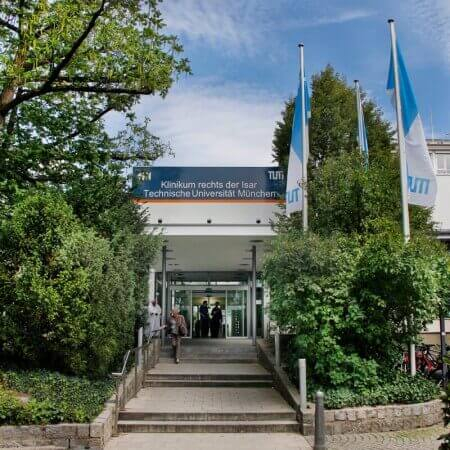Subclavian artery stenosis is a narrowing of the corresponding blood vessel. It most often narrows due to atherosclerosis, which causes deposits of cholesterol plaques inside the artery. This disease is successfully treated in German Vascular Surgery Centers with a minimally invasive procedure that involves angioplasty and stenting. Surgery is less commonly performed. Surgical options may include bypass surgery or subclavian carotid transposition.
Content
- Treatment principles
- Endovascular treatment
- Surgical interventions
German medical centers mostly treat the disease with endovascular procedures such as angioplasty and stent implantation. An operation, namely carotid-subclavian bypass surgery, is performed less often. Other surgical interventions for stenosis treatment are very rarely used. These may be subclavian-axillary bypass or subclavian carotid transposition.
You can undergo your treatment in one of the following hospitals: University Hospital Rechts der Isar Munich, Hospital Kassel, or University Hospital Halle.
If you make your treatment appointment through the Booking Health service, we will take care of the arrangements for your trip. Our specialists will help you to select a specialized clinic, tell you about modern treatment methods, and make an appointment for the nearest date. After that, we will help you to apply for a visa and come to the clinic. You will also be accompanied by an interpreter for easier communication with German doctors.
Treatment principles
As a rule, subclavian artery stenosis does not cause any severe symptoms. Patients receive conservative treatment, namely drugs to control arterial hypertension, statins, and sometimes also antiplatelet agents.
The progression of stenosis causes the following two problems:
- ischemia (oxygen deprivation) in the tissues of the upper limb;
- steal syndrome, which impairs blood supply to the brain.
In such cases, invasive treatment is required. The treatment of subclavian artery stenosis in Germany mostly involves the use of endovascular techniques. These are considered among the first-line treatment options. Surgeons rarely resort to open operations, namely bypass surgery.
Endovascular treatment
Endovascular treatment is performed from inside the blood vessels under X-ray guidance. Doctors make a small incision in the leg or arm, reach the subclavian artery, and then expand its lumen. There are two main techniques that can be used in the fight against stenosis:
- angioplasty is an expansion of the artery with a balloon from the inside, due to its inflation;
- stent implantation is a placement of a stent inside the blood vessel, which expands the lumen and holds it.
Doctors use both self-expanding and balloon-expandable stents for stent placement. Endovascular procedures are minimally traumatic, performed under local anesthesia, and do not require long-term rehabilitation. They provide patients with good and long-term results.
Surgical interventions
Many operations have been developed for the surgical treatment of subclavian artery stenosis, but some of them are no longer used in developed countries. The operations are divided into transthoracic (performed through the thorax) and extrathoracic ones.
Transthoracic operations include endarterectomy: the removal of the inner layer of the blood vessel along with atherosclerotic plaques. However, this treatment option is too traumatic, so it is not used in modern hospitals.
Doctors in Germany perform extrathoracic surgery. Basically, this is bypass surgery involving the formation of a blood flow path around the narrowed section of the subclavian artery. Subclavian carotid transposition is used less often. This procedure aims to switch the subclavian artery to the common carotid artery.
Bypass surgery instead of an endovascular intervention is usually used only in cases when the effect cannot be achieved with a minimally invasive procedure. This operation can also be performed in patients at low surgical risk as this treatment option provides patients with long-term results as compared to stent implantation.
An implant (a vascular prosthesis) made of artificial materials is usually used for bypass surgery. Depending on which blood vessels it connects, bypass surgery can be:
- carotid-subclavian one is the main treatment option;
- subclavian-axillary one is used as an alternative option if carotid-subclavian bypass surgery cannot be performed.
Subclavian carotid transposition is performed if the artery has narrowed not as a result of atherosclerosis, but due to external compression, for example, due to anomalies of the aortic arch and brachiocephalic arteries. This treatment option is also considered the first choice for proximal subclavian artery stenosis.
You are welcome to use the Booking Health service to undergo your diagnostics and treatment of subclavian artery stenosis in Germany. On our website, you can find the cost of a medical care program and book your treatment appointment at the clinic at a favorable price. Our specialists will select the most suitable clinics in Germany and take care of the arrangements for your trip.
Authors:
The article was edited by medical experts, board-certified doctors Dr. Nadezhda Ivanisova and Dr. Sergey Pashchenko. For the treatment of the conditions referred to in the article, you must consult a doctor; the information in the article is not intended for self-medication!
Sources:
Medscape
Johns Hopkins Medicine
Google Scholar












